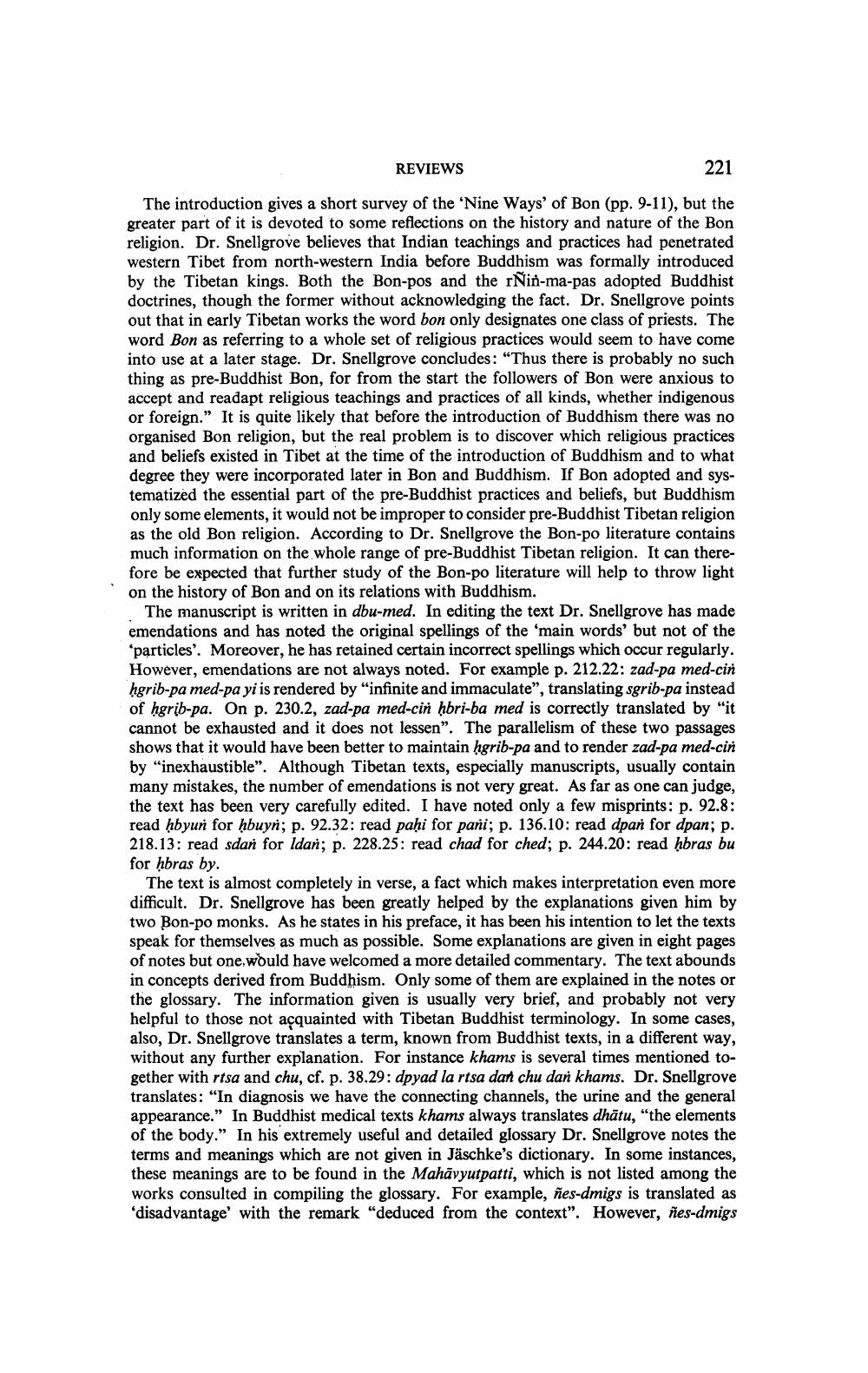________________ REVIEWS 221 The introduction gives a short survey of the 'Nine Ways' of Bon (pp. 9-11), but the greater part of it is devoted to some reflections on the history and nature of the Bon religion. Dr. Snellgrove believes that Indian teachings and practices had penetrated western Tibet from north-western India before Buddhism was formally introduced by the Tibetan kings. Both the Bon-pos and the rNin-ma-pas adopted Buddhist doctrines, though the former without acknowledging the fact. Dr. Snellgrove points out that in early Tibetan works the word bon only designates one class of priests. The word Bon as referring to a whole set of religious practices would seem to have come into use at a later stage. Dr. Snellgrove concludes: "Thus there is probably no such thing as pre-Buddhist Bon, for from the start the followers of Bon were anxious to accept and readapt religious teachings and practices of all kinds, whether indigenous or foreign." It is quite likely that before the introduction of Buddhism there was no organised Bon religion, but the real problem is to discover which religious practices and beliefs existed in Tibet at the time of the introduction of Buddhism and to what degree they were incorporated later in Bon and Buddhism. If Bon adopted and systematized the essential part of the pre-Buddhist practices and beliefs, but Buddhism only some elements, it would not be improper to consider pre-Buddhist Tibetan religion as the old Bon religion. According to Dr. Snellgrove the Bon-po literature contains much information on the whole range of pre-Buddhist Tibetan religion. It can therefore be expected that further study of the Bon-po literature will help to throw light on the history of Bon and on its relations with Buddhism. The manuscript is written in dbu-med. In editing the text Dr. Snellgrove has made emendations and has noted the original spellings of the 'main words' but not of the 'particles'. Moreover, he has retained certain incorrect spellings which occur regularly. However, emendations are not always noted. For example p. 212.22: zad-pa med-cin hgrib-pa med-pa yi is rendered by "infinite and immaculate", translating sgrib-pa instead of hgrib-pa. On p. 230.2, zad-pa med-cin "bri-ba med is correctly translated by "it cannot be exhausted and it does not lessen". The parallelism of these two passages shows that it would have been better to maintain hgrib-pa and to render zad-pa med-cin by "inexhaustible". Although Tibetan texts, especially manuscripts, usually contain many mistakes, the number of emendations is not very great. As far as one can judge, the text has been very carefully edited. I have noted only a few misprints: p. 92.8: read hbyun for ubuyn; p. 92.32: read pahi for pani; p. 136.10: read dpan for dpan; p. 218.13: read sdan for ldan; p. 228.25: read chad for ched; p. 244.20: read nbras bu for nbras by. The text is almost completely in verse, a fact which makes interpretation even more difficult. Dr. Snellgrove has been greatly helped by the explanations given him by two Bon-po monks. As he states in his preface, it has been his intention to let the texts speak for themselves as much as possible. Some explanations are given in eight pages of notes but one would have welcomed a more detailed commentary. The text abounds in concepts derived from Buddhism. Only some of them are explained in the notes or the glossary. The information given is usually very brief, and probably not very helpful to those not acquainted with Tibetan Buddhist terminology. In some cases, also, Dr. Snellgrove translates a term, known from Buddhist texts, in a different way, without any further explanation. For instance khams is several times mentioned together with rtsa and chu, cf. p. 38.29: dpyad la rtsa dan chu dan khams. Dr. Snellgrove translates: "In diagnosis we have the connecting channels, the urine and the general appearance." In Buddhist medical texts khams always translates dhatu, "the elements of the body." In his extremely useful and detailed glossary Dr. Snellgrove notes the terms and meanings which are not given in Jaschke's dictionary. In some instances, these meanings are to be found in the Mahavyutpatti, which is not listed among the works consulted in compiling the glossary. For example, nes-dmigs is translated as 'disadvantage with the remark "deduced from the context". However, nes-dmigs




